| Western blot (WB): | 1:500-2000 |
| Immunohistochemistry (IHC): | 1:50-400 |
| Immunocytochemistry/Immunofluorescence (ICC/IF): | 1:50-400 |
| Flow Cytometry (Fixed): | 1:50-200 |
| Enzyme linked immunosorbent assay (ELISA): | 1:100-1000 |
| (Boiling the paraffin sections in 10mM citrate buffer,pH6.0,or PH8.0 EDTA repair liquid for 20 mins is required for the staining of formalin/paraffin sections.) Optimal working dilutions must be determined by end user. | |
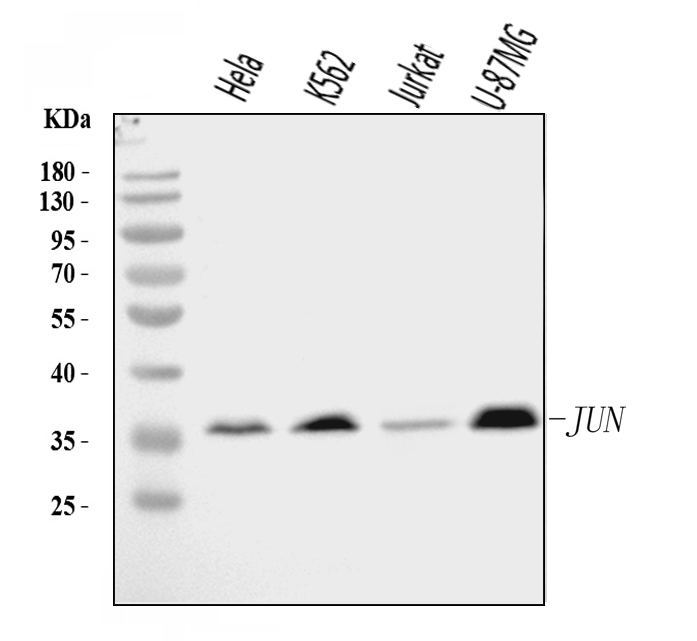
Western blot analysis of c-Jun/JUN using anti-c-Jun/JUN antibody (A02038-3). The sample well of each lane was loaded with 30 ug of sample under reducing conditions.
Lane 1: HELA whole cell lysates,
Lane 2: K562 whole cell lysates,
Lane 3: Jurkat whole cell lysates,
Lane 4: U-87MG whole cell lysates.
After electrophoresis, proteins were transferred to a membrane. Then the membrane was incubated with rabbit anti-c-Jun/JUN antigen affinity purified polyclonal antibody (A02038-3) at a dilution of 1:1000 and probed with a goat anti-rabbit IgG-HRP secondary antibody (Catalog # BA1054). The signal is developed using ECL Plus Western Blotting Substrate (Catalog # AR1197). A specific band was detected for c-Jun/JUN at approximately 36-48 kDa. The expected band size for c-Jun/JUN is at 36 kDa.
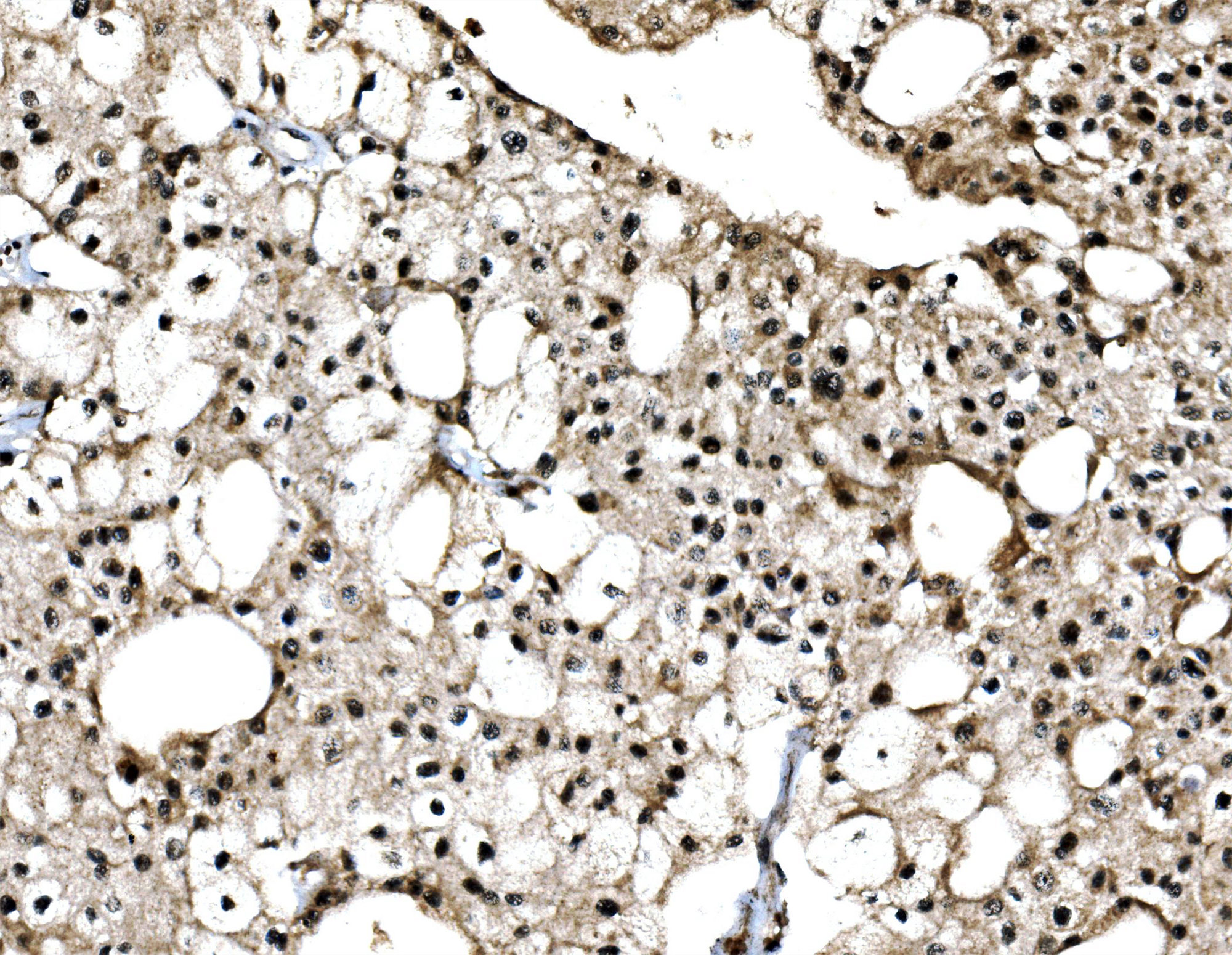
IHC analysis of c-Jun/JUN using anti-c-Jun/JUN antibody (A02038-3).
c-Jun/JUN was detected in a paraffin-embedded section of human renal cell carcinoma tissue. Biotinylated goat anti-rabbit IgG was used as secondary antibody. The tissue section was incubated with rabbit anti-c-Jun/JUN Antibody (A02038-3) at a dilution of 1:200 and developed using Strepavidin-Biotin-Complex (SABC) (Catalog # SA1022) with DAB (Catalog # AR1027) as the chromogen.
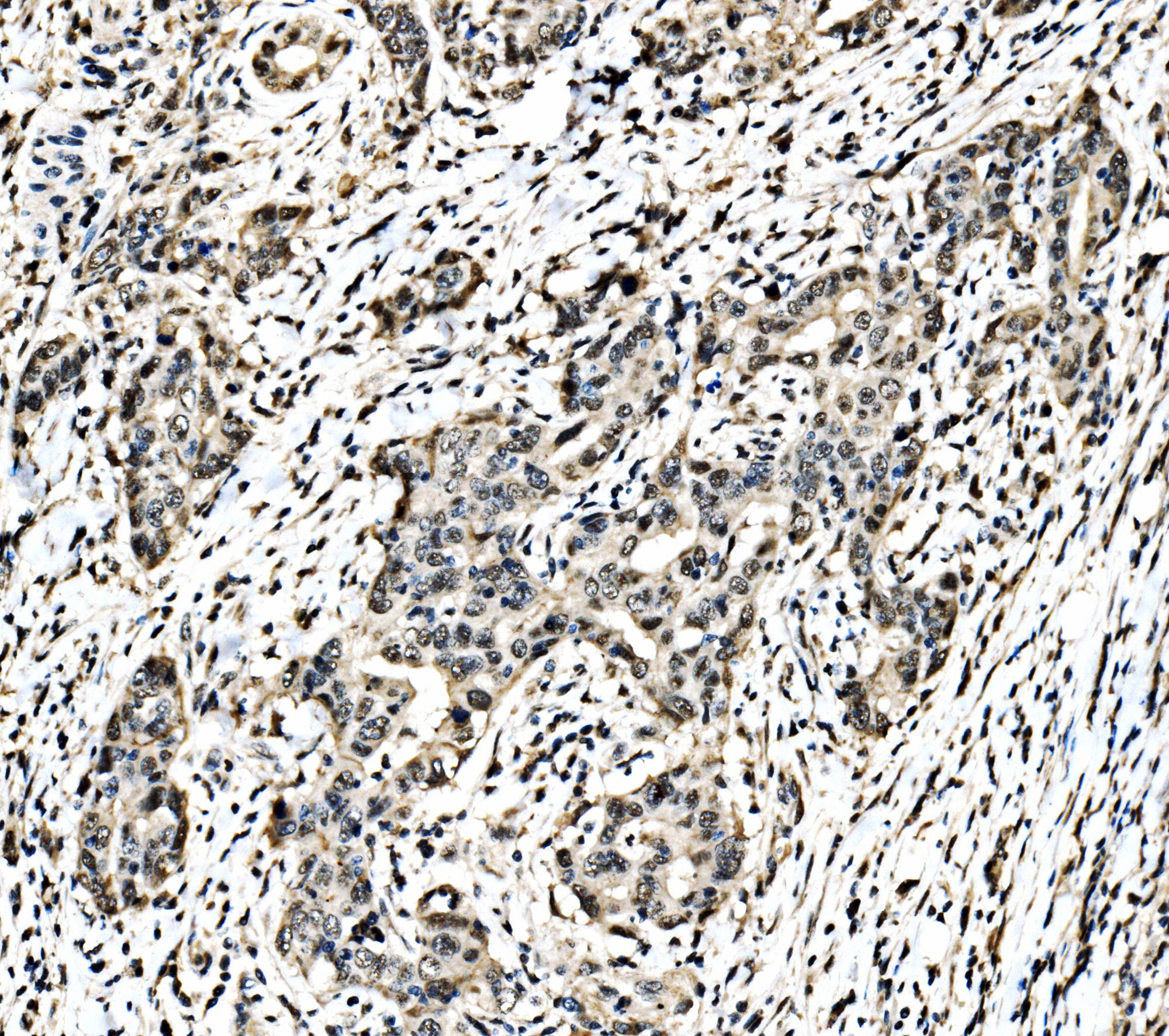
IHC analysis of c-Jun/JUN using anti-c-Jun/JUN antibody (A02038-3).
c-Jun/JUN was detected in a paraffin-embedded section of human the renal pelvis is squamous metaplasia tissue. Biotinylated goat anti-rabbit IgG was used as secondary antibody. The tissue section was incubated with rabbit anti-c-Jun/JUN Antibody (A02038-3) at a dilution of 1:200 and developed using Strepavidin-Biotin-Complex (SABC) (Catalog # SA1022) with DAB (Catalog # AR1027) as the chromogen.
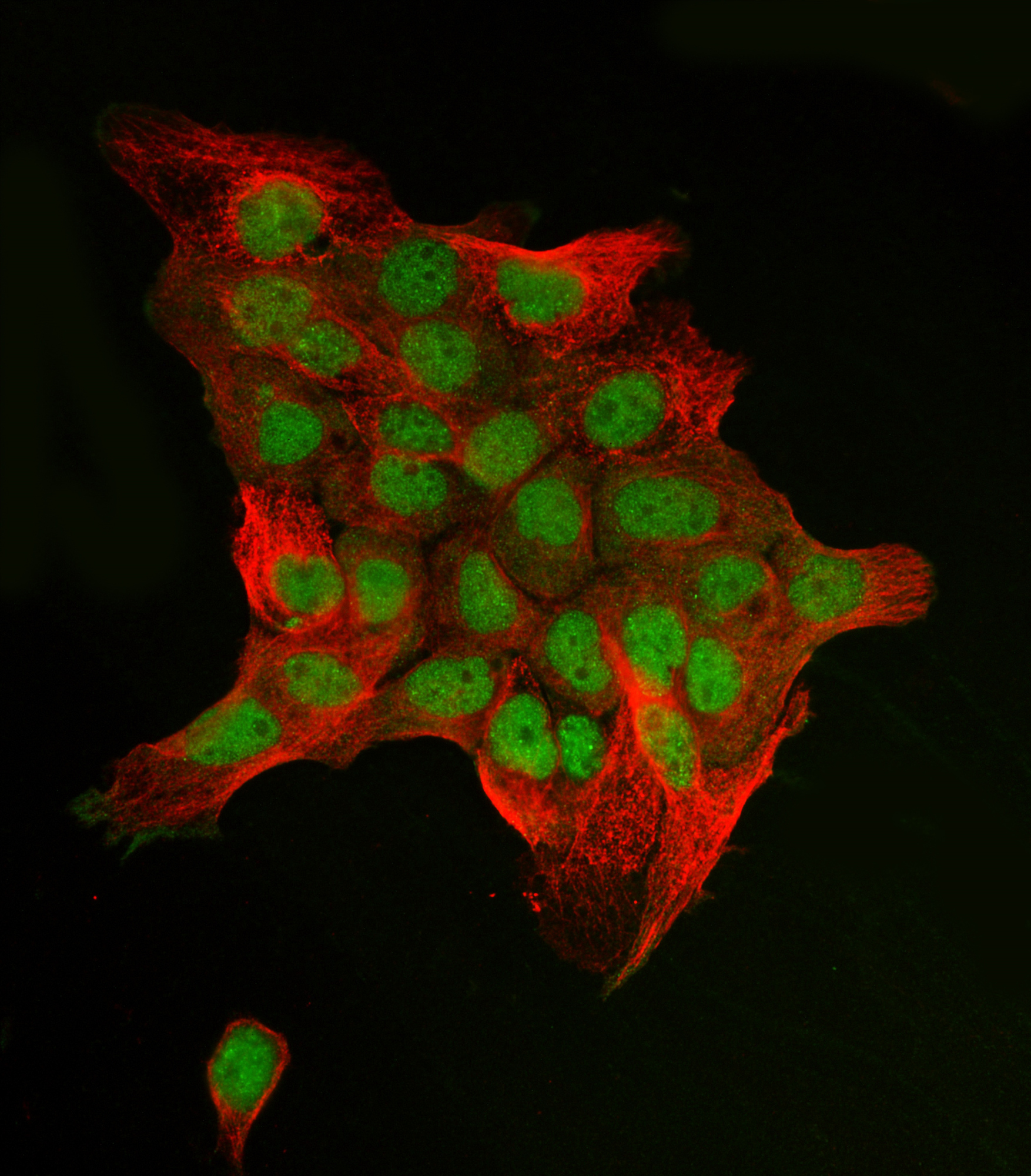
IF analysis of c-Jun/JUN using anti-c-Jun/JUN antibody (A02038-3) and anti-Beta Tubulin antibody (M01857-3).
c-Jun/JUN was detected in an immunocytochemical section of A431 cells. The section was incubated with rabbit anti-c-Jun/JUN Antibody (A02038-3) at a dilution of 1:100. Dylight488-conjugated Anti-rabbit IgG Secondary Antibody (green)(Catalog#BA1127) and Dylight594-conjugated Anti-mouse IgG Secondary Antibody (red)(Catalog#BA1141) were used as secondary antibody.
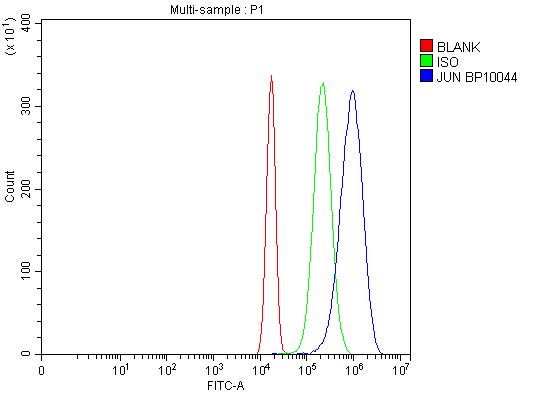
Flow Cytometry analysis of U2OS cells using anti-c-Jun/JUN antibody (A02038-3).
Overlay histogram showing U2OS cells stained with A02038-3 (Blue line). To facilitate intracellular staining, cells were fixed with 4% paraformaldehyde and permeabilized with permeabilization buffer. The cells were blocked with 10% normal goat serum. And then incubated with rabbit anti-c-Jun/JUN Antibody (A02038-3) at 1:100 dilution for 30 min at 20°C. DyLight®488 conjugated goat anti-rabbit IgG (BA1127) was used as secondary antibody at 1:100 dilution for 30 minutes at 20°C. Isotype control antibody (Green line) was rabbit IgG at 1:100 dilution used under the same conditions. Unlabelled sample without incubation with primary antibody and secondary antibody (Red line) was used as a blank control.

Western blot analysis of c-Jun/JUN using anti-c-Jun/JUN antibody (A02038-3). The sample well of each lane was loaded with 30 ug of sample under reducing conditions.
Lane 1: HELA whole cell lysates,
Lane 2: K562 whole cell lysates,
Lane 3: Jurkat whole cell lysates,
Lane 4: U-87MG whole cell lysates.
After electrophoresis, proteins were transferred to a membrane. Then the membrane was incubated with rabbit anti-c-Jun/JUN antigen affinity purified polyclonal antibody (A02038-3) at a dilution of 1:1000 and probed with a goat anti-rabbit IgG-HRP secondary antibody (Catalog # BA1054). The signal is developed using ECL Plus Western Blotting Substrate (Catalog # AR1197). A specific band was detected for c-Jun/JUN at approximately 36-48 kDa. The expected band size for c-Jun/JUN is at 36 kDa.

IHC analysis of c-Jun/JUN using anti-c-Jun/JUN antibody (A02038-3).
c-Jun/JUN was detected in a paraffin-embedded section of human renal cell carcinoma tissue. Biotinylated goat anti-rabbit IgG was used as secondary antibody. The tissue section was incubated with rabbit anti-c-Jun/JUN Antibody (A02038-3) at a dilution of 1:200 and developed using Strepavidin-Biotin-Complex (SABC) (Catalog # SA1022) with DAB (Catalog # AR1027) as the chromogen.

IHC analysis of c-Jun/JUN using anti-c-Jun/JUN antibody (A02038-3).
c-Jun/JUN was detected in a paraffin-embedded section of human the renal pelvis is squamous metaplasia tissue. Biotinylated goat anti-rabbit IgG was used as secondary antibody. The tissue section was incubated with rabbit anti-c-Jun/JUN Antibody (A02038-3) at a dilution of 1:200 and developed using Strepavidin-Biotin-Complex (SABC) (Catalog # SA1022) with DAB (Catalog # AR1027) as the chromogen.

IF analysis of c-Jun/JUN using anti-c-Jun/JUN antibody (A02038-3) and anti-Beta Tubulin antibody (M01857-3).
c-Jun/JUN was detected in an immunocytochemical section of A431 cells. The section was incubated with rabbit anti-c-Jun/JUN Antibody (A02038-3) at a dilution of 1:100. Dylight488-conjugated Anti-rabbit IgG Secondary Antibody (green)(Catalog#BA1127) and Dylight594-conjugated Anti-mouse IgG Secondary Antibody (red)(Catalog#BA1141) were used as secondary antibody.

Flow Cytometry analysis of U2OS cells using anti-c-Jun/JUN antibody (A02038-3).
Overlay histogram showing U2OS cells stained with A02038-3 (Blue line). To facilitate intracellular staining, cells were fixed with 4% paraformaldehyde and permeabilized with permeabilization buffer. The cells were blocked with 10% normal goat serum. And then incubated with rabbit anti-c-Jun/JUN Antibody (A02038-3) at 1:100 dilution for 30 min at 20°C. DyLight®488 conjugated goat anti-rabbit IgG (BA1127) was used as secondary antibody at 1:100 dilution for 30 minutes at 20°C. Isotype control antibody (Green line) was rabbit IgG at 1:100 dilution used under the same conditions. Unlabelled sample without incubation with primary antibody and secondary antibody (Red line) was used as a blank control.






